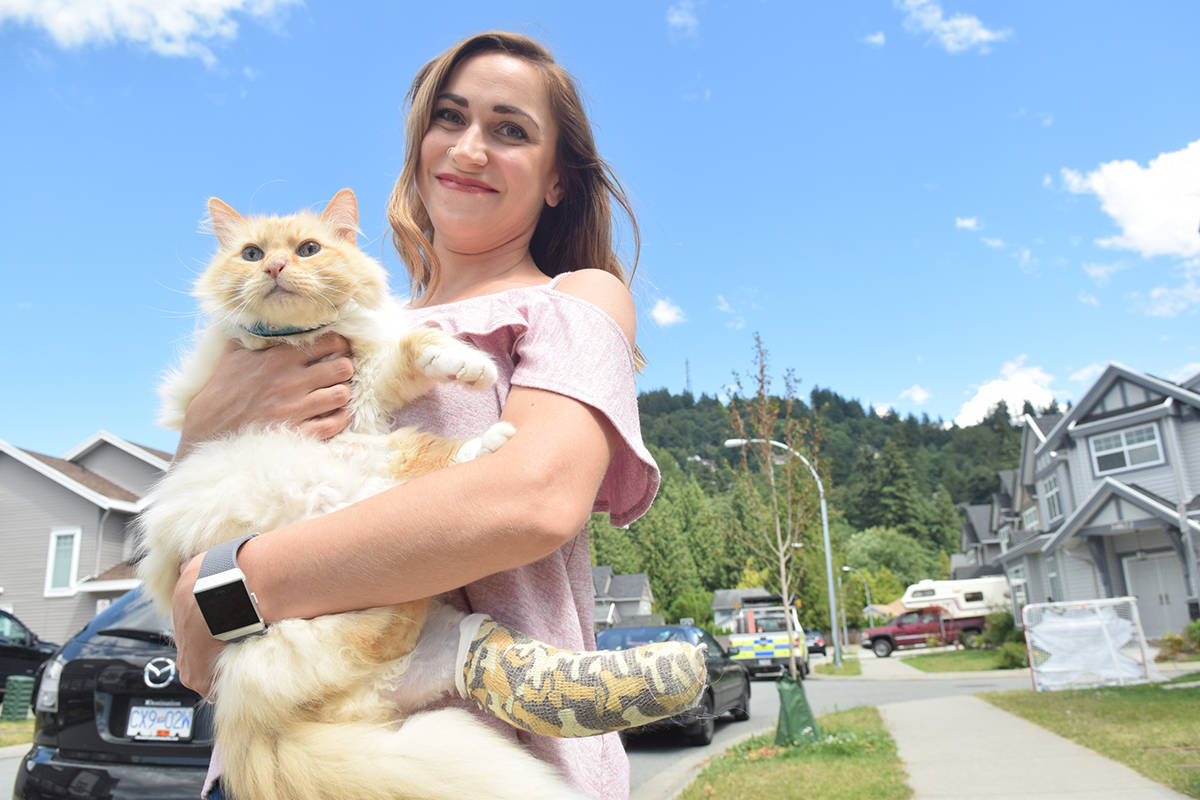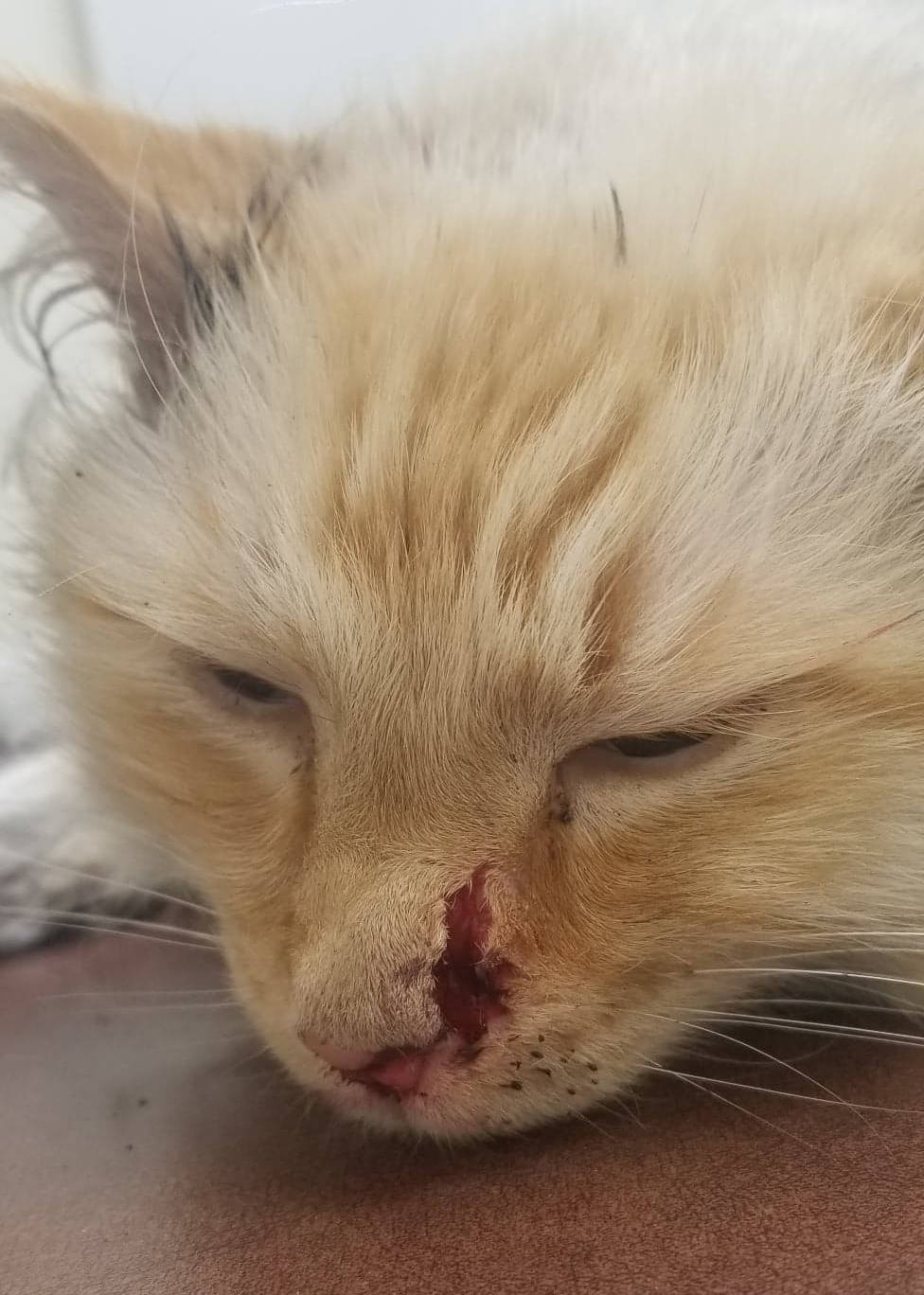A ravenous gang of raccoons is being blamed for attacks on dozens of cats in the McMillan area of Abbotsford over the last two years. Some of the felines have been killed and mostly eaten, their bodies left behind in grisly circumstances, while others have survived and made it to the local animal hospital in fragile health.
In at least four recent cases, residents have intervened just in time, beating a pack of raccoons off of a cat, according to Janice Toplass, the office manager at the Glenn Mountain Animal Hospital, at the intersection of McMillan and Old Yale Road. Toplass, who lives nearby and whose own cat was killed in an attack last November, has posted in the window of the animal hospital a warning to local pet owners about the raccoon danger.
Just a block to the north, Megan Giesbrecht was woken in early June by the sound of an animal fight outside her McMillan Place home. Her husband went outside and found four animals swarming her 15-year-old cat, Hendrix. He beat off the raccoons and rescued Hendrix, who was severely wounded. His face was lacerated and one of his legs had been broken in two separate places. He’s recovering now, and remaining indoors. A security camera on the couple’s back patio captured the moments leading to the attack: Hendrix had been under a chair near the couple’s back door when a pair of raccoons raced up from beneath a nearby fence; the cat fled, only for two more raccoons to join the pursuit from a nearby street. (The actual attack is not seen.)
Last week, three raccoons chased Leona Schneider’s two-year-old cat Oliver onto the patio of Schneider’s home and began attacking it. Schneider’s husband rushed out and chased the animals off, but the cat also fled. Oliver was missing for two days, before returning with three bite wounds – two on the back leg, one on the lower stomach. He is now battling an infection, but might be considered one of the lucky ones.
Since the attack, Schneider learned her next-door neighbour had recently found a dead cat in her yard, and Toplass said there have been many more killings.
Coyotes have long posed an occasional threat to cats on Sumas Mountain, but Toplass said they tend to leave little evidence of their killing behind, preferring to carry their prey back to their dens.
But most cats killed in the last two years have been only partially devoured, then left to rot.
“They’re leaving them quite a mess,” she said. “The raccoons are just killing, eating what they want, and leaving the body there for whatever purpose.”
One client’s cat was “pulled through a fence and ripped to pieces,” Toplass said
Raccoons are not typically predators, according to Breanna Glinnum, the animal care supervisor at the Langley-based Critter Care Wildlife Society.
“They’re more opportunistic eaters,” she said. “They’re going to look for the easiest, laziest way to get food.”
That easy source of food is probably not cats, she said. But, it might be the feline’s own food, if it’s left outside. Raccoons can be very territorial and protective of food sources; if they consider another animal a threat, they may look to run it off. And mothers may keep their cubs around for up to two years.
“Raccoons generally aren’t confrontational animals,” she said. “They don’t seek out fights with other animals. Obviously if they’re an abundant food source, they’re going to be protective of that.”
Glinnum believes cats should be kept inside. But if they are let outside, their food should remain indoors.
“If people are feeding their cats outside … that’s going to number one attract raccoons and number two, raccoons are going to be protective of that.”
Once a cat is dead, Glinnum noted, a raccoon may – or may not – decide that it’s worth eating. She and veterinarian Ken Macquisten both said raccoons generally get “a bad rap,” with Macquisten noting that most cat injuries attributed to raccoons are caused by other felines.
Still, in the McMillan cases, there are the eyewitnesses, the video evidence, and those half-eaten carcasses. Stories of gangs of raccoons killing cats aren’t common, but they do crop up from time to time, with Richmond experiencing a pair of attacks seven years ago.
Local conservation officer Don Stahl said he and his colleagues have too many cougars and bear calls to be able to respond raccoon complaints. He says cat food, birdseed and other attractants should be kept indoors. But residents can also take more proactive action, he noted.
Trapping animals like raccoons, skunks and porcupines is legal without a permit. Humane traps can be purchased from sporting goods stores, and if an animal is caught, it must be relocated within 24 hours to a site within 10 kilometres.
But catching a raccoon isn’t easy. Toplass, the animal hospital office manager, said she tried for two months to snare one of the critters believed to have killed her cat. During that time, she only caught one animal: a local neighbourhood cat.
That, in itself, might be worth noting. With many cats killed or kept indoors now, Toplass said the felines that used to populate her street have all but disappeared.
“There aren’t many cats around anymore,” she said.
@ty_olsen
tolsen@abbynews.com
Like us on Facebook and follow us on Twitter.

